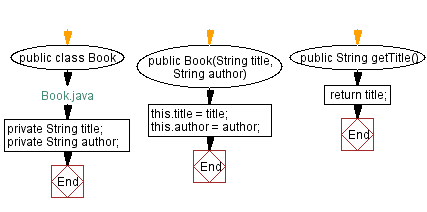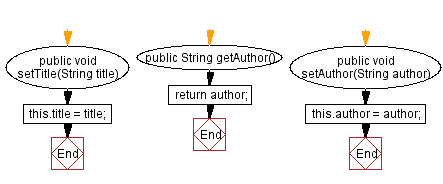Java: Library class with add and remove books methods
Write a Java program to create a class called "Library" with a collection of books and methods to add and remove books.
Sample Solution:
Java Code:
// Book.java
// Define the Book class
public class Book {
// Private field to store the title of the book
private String title;
// Private field to store the author of the book
private String author;
// Constructor to initialize the title and author fields
public Book(String title, String author) {
// Assign the title parameter to the title field
this.title = title;
// Assign the author parameter to the author field
this.author = author;
}
// Getter method for the title field
public String getTitle() {
// Return the value of the title field
return title;
}
// Setter method for the title field
public void setTitle(String title) {
// Assign the title parameter to the title field
this.title = title;
}
// Getter method for the author field
public String getAuthor() {
// Return the value of the author field
return author;
}
// Setter method for the author field
public void setAuthor(String author) {
// Assign the author parameter to the author field
this.author = author;
}
}
The above class has two private attributes, "title" and "author". It has a constructor that takes two arguments, the title and author of the book, and initializes the corresponding attributes. It also has getter and setter methods to access and modify the title and author attributes.
// Library.java
// Import the ArrayList class from the java.util package
import java.util.ArrayList;
// Define the Library class
public class Library {
// Private field to store a list of Book objects
private ArrayList<Book> books;
// Constructor to initialize the books field
public Library() {
// Create a new ArrayList to hold Book objects
books = new ArrayList<Book>();
}
// Method to add a Book to the books list
public void addBook(Book book) {
// Add the specified book to the books list
books.add(book);
}
// Method to remove a Book from the books list
public void removeBook(Book book) {
// Remove the specified book from the books list
books.remove(book);
}
// Method to get the list of books
public ArrayList<Book> getBooks() {
// Return the list of books
return books;
}
}
The above "Library" class has a private books attribute, which is an ArrayList of Book objects. The Library constructor initializes this attribute as an empty list. The "addBook()" method adds a Book object to the books list, while the “removeBook()” method removes a Book object from the list. The “getBooks()” method returns the books list.
// Main.java
// Define the Main class
public class Main {
// Main method, entry point of the program
public static void main(String[] args) {
// Create a new instance of the Library class
Library library = new Library();
// Create new Book objects with title and author
Book book1 = new Book("Adventures of Tom Sawyer", "Mark Twain");
Book book2 = new Book("Ben Hur", "Lewis Wallace");
Book book3 = new Book("Time Machine", "H.G. Wells");
Book book4 = new Book("Anna Karenina", "Leo Tolstoy");
// Add the books to the library
library.addBook(book1);
library.addBook(book2);
library.addBook(book3);
library.addBook(book4);
// Print a message to indicate the books in the library
System.out.println("Books in the library:");
// Iterate through the list of books in the library
for (Book book : library.getBooks()) {
// Print the title and author of each book
System.out.println(book.getTitle() + " by " + book.getAuthor());
}
// Remove a book from the library
library.removeBook(book2);
// Print a message to indicate the books in the library after removal
System.out.println("\nBooks in the library after removing " + book2.getTitle() + ":");
// Iterate through the updated list of books in the library
for (Book book : library.getBooks()) {
// Print the title and author of each book
System.out.println(book.getTitle() + " by " + book.getAuthor());
}
}
}
In the above class, we create an instance of the Library class and add two Book objects to the collection using the “addBook()” method. We then display the books in the library using the “displayBooks()” method. We remove one of the books using the “removeBook()” method and display the updated collection of books in the library.
Sample Output:
Books in the library: Adventures of Tom Sawyer by Mark Twain Ben Hur by Lewis Wallace Time Machine by H.G. Wells Anna Karenina by Leo Tolstoy Books in the library after removing Ben Hur: Adventures of Tom Sawyer by Mark Twain Time Machine by H.G. Wells Anna Karenina by Leo Tolstoy
Flowchart:


For more Practice: Solve these Related Problems:
- Write a Java program where the "Library" class tracks due dates and calculates late fees for borrowed books.
- Write a Java program to modify the "Library" class to allow book reservations if all copies are checked out.
- Write a Java program where the "Library" class maintains a waiting list for popular books.
- Write a Java program to add a search function in the "Library" class to find books by author or title.
Go to:
Java Code Editor:
Improve this sample solution and post your code through Disqus.
PREV : Manage student courses using the Student class.
NEXT : Airplane class to check flight status and delay.
What is the difficulty level of this exercise?
Test your Programming skills with w3resource's quiz.
